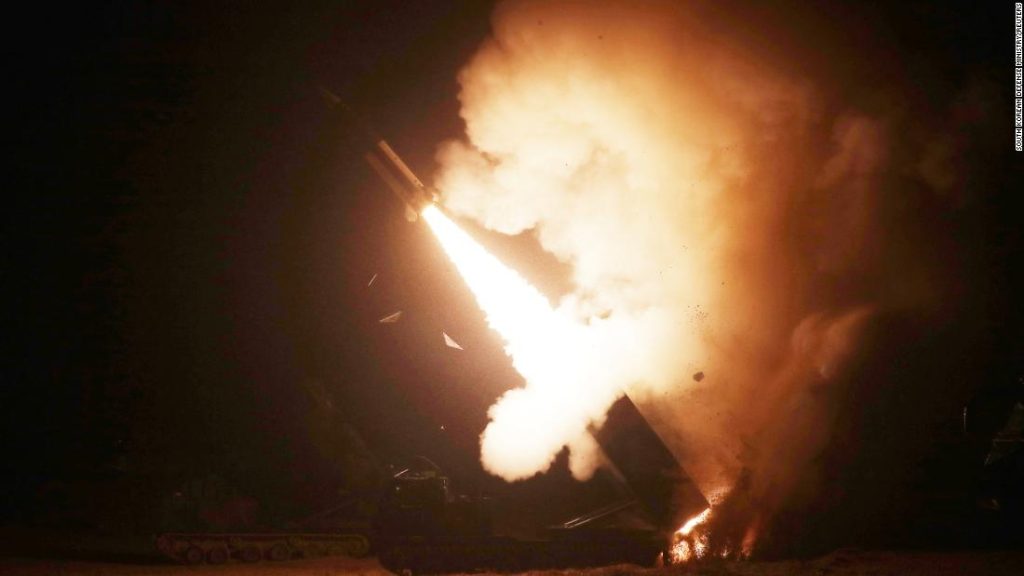US and South Korea test-fire missiles in continued response after North Korea launch | CNN

Seoul, South Korea
CNN
—
The United States and South Korea launched four missiles off the east coast of the Korean Peninsula on Wednesday morning local time, according to South Korea’s Joint Chiefs of Staff.
The test was the allies’ second exercise in under 24 hours, following a provocative test-launch Tuesday morning by neighboring North Korea, which fired a ballistic missile without warning over Japan in a significant escalation of its weapons testing program.
The US and South Korea initially responded to the provocation with a precision bombing exercise on Tuesday, which involved a South Korean F-15K fighter jet firing two air-to-surface munitions at a virtual target in a firing range west of the Korean Peninsula, per the South Korean Joint Chiefs.
The allies typically respond to missile tests by North Korea with military exercises.
Wednesday’s launch included four ATACMS missiles, the statement by the South Korean Joint Chiefs said. Also known as Army Tactical Missile Systems, such weapons are surface-to-surface missiles that can fly around 200 miles (320 kilometers).
According to John Kirby, the National Security Council coordinator for strategic communications, the launch was designed to demonstrate that the US and its allies have “the military capabilities at the ready to respond to provocations by the North.”
“This is not the first time we’ve done this in response to provocations by the North to make sure that we can demonstrate our own capabilities,” Kirby told CNN’s Pamela Brown on the “The Situation Room with Wolf Blitzer.”
“We want to see the denuclearization of the Korean Peninsula, (North Korean leader Kim Jong Un) hasn’t shown an inclination to move in that direction, quite frankly he’s moving in the opposite direction by continuing to conduct these missile tests which are violations of security council resolutions,” he added.
On Tuesday, the US and Japan also conducted a joint response to the North Korean launch, with US Marine Corps and Japan Air Self-Defense Force fighter jets flying over the Sea of Japan, also known as the East Sea.
Following a 25-minute phone call with US President Joe Biden, Japanese Prime Minister Fumio Kishida said North Korea’s latest launch posed “a grave challenge to peace and the stability of Japan, the region and the international community” and that Biden shared this view completely.
Analysts say there’s little the US and its allies can do to stop Kim’s relentless weapons buildup.
“The North Koreans are in no mood to talk. They’re in the mood of testing and blowing things off,” said Jeffrey Lewis, director of the East Asia Nonproliferation Project at the Middlebury Institute of International Studies.
Failed US-North Korea summits during the Trump administration have led Kim to believe he can gain nothing from talks, Lewis said.
Since 2019 negotiations with former US President Donald Trump were cut short with no agreement, the North Korean leader has laid out a program to develop missiles with nuclear capability – and he’s following that timetable, Lewis added.
“North Korea is going to keep conducting missile tests until the current round of modernization is done. I don’t think a nuclear (test) explosion is far behind,” Lewis said.
Kirby, the National Security Council spokesperson, said North Korea is making progress.
Every time the Kim regime launches a weapon, “They learn, they get better, they get more capable,” he said in an interview with Fox News on Tuesday.
Ankit Panda, senior fellow at the Carnegie Endowment for International Peace, said North Korea appeared set on a course to develop nuclear weapons.
“Denuclearization is now I think in the dustbin of history as a failed policy,” he said.
“There is simply no practical plan at this point, especially in the short term, to bring North Korea to the negotiating table and to pursue denuclearization.”







